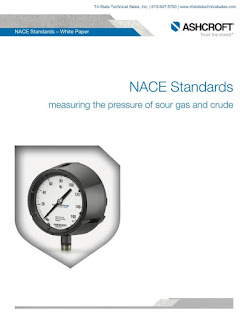NACE Standards White Paper: Measuring the Pressure of Sour Gas and Crude
White paper courtesy of Ashcroft.
Every mechanically activated pressure instrument relies on an elastic element to bend in response to a pressurized medium. Most often, the element is a metallic “C” shaped or coiled Bourdon tube that attempts to straighten under pressure. Specifiers need to be especially careful that the chemical composition of the excitation medium does not react unfavorably with the instrument’s wetted materials. Measuring the pressure of compressed air or water seldom results in an incompatibility. However, when oil and gas first come out of the ground, the story can be quite different. Both hydrogen sulfide (H2S) and carbon dioxide (CO2, when combined with water forms carbonic acid) can exist as unwanted components. Raw petroleum fluids infused with hydrogen sulfide are known as “sour gas” or “sour crude”, and can attack containment materials, causing stress corrosion cracking. This can lead to a breach in the vessel and allow gas or oil to escape into the surrounding environment. The consequences can be disastrous.
